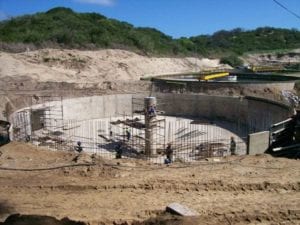Residential development in the municipal area of Buffalo City will soon receive a shot in the arm, due to the increased capacity of the Quinera Wastewater Treatment Works (QWWTW) near Gonubie, East London.
The facility was nearing the limits of its installed capacity, and concerns about the possible overloading of the QWWTW resulted in Buffalo City Municipality (BCM) placing a moratorium on any new developments in the Quinera and Gonubie areas until its capacity could be upgraded. Background The BCM appointed SRK Consulting to investigate and estimate the future loading of the works; the findings of SRK’s report were published in September 2005, where it recommended that an upgrade was necessary – from the existing capacity of 6 Mℓ/d to 18 Mℓ/d – to accommodate future growth of the area. Phase 1 of the project was completed in September 2009, and focused on the civil and mechanical aspects of the expansion, including the construction of a new concrete inlet works with rotating mechanical screens and vortex degritter, a new splitter box to distribute the screened sewage to two aerobic reactors, and a new waste-activated sludge dewatering system. It also included the construction of a new substation building and alterations to the existing buildings. As principal agent, SRK worked with principal contractor Erbacon Construction and mechanical subcontractors Huber Technology and Sulzer (previously ABS) on this part of the project. Second phase In August 2012, the second and final phase of the project got underway, dealing with the electrical and electronic works, with a joint venture of Ursa Civils and Give Ziyawa as principal contractor. “In May 2013, we were about 50% through the construction of Phase 2, with commissioning scheduled to be completed by the end of November,” says Marinus Meiring, principal engineering technologist at SRK. The Phase 2 contract, worth about R45 million, comprises the supply, installation, and commissioning of:- mediumvoltage (11 kV) and lowvoltage (600/1000 V) underground cables
- indoor 11 kV and lowvoltage switchgear
- standby diesel alternator plant
- motor control equipment
- electronic programmable logic controllers (PLC)
- flow measurement systems
- supervisory control and data acquisition (SCADA) systems
- ventilation and fire detection systems
- associated electrical and electronic equipment.
The new plant boasts a high level of automation, with the electronic engineering scope of work including access control systems and CCTV in addition to the SCADA installation, monitoring equipment (for flow, level and effluent quality) and the PLC controls for the plant and motor control systems.
“The major benefit of these new automated systems is that the operator will be able to see, in real time, the key parameters of the plant’s operation,” points out Meiring. “This will allow him to make adjustments immediately on the basis of changed conditions, such as variations in the quality of incoming effluent. “The systems will also monitor the quality of the treated effluent being discharged, and will make this information available in realtime. The operator is then able to check that this quality is within compliance criteria, and can take corrective steps if necessary.” Energy-efficient aeration A significant innovation in the new facility is the use of fine-bubble aeration instead of conventional surface aerators.While this is not a new technology in itself, it will be the first time it is being applied in Buffalo City. “This aeration method involves pumping air down a series of pipes to the bottom of the reactor tank so that bubbles rise through the effluent,” says Meiring. “This is much more energy efficient in terms of kilowatt hours of electricity per milligram of oxygen supplied.” The aeration is vital to provide oxygen for bacteria in the reactor, to break down effluent and reduce odour. Apart from its normal automatic mode of operation, the integrated plant will also be able to run in an off-peak auto mode; this will allow reduced operation of the blowers during peak electricity tariff periods, if the flow load is light enough. The works will also be able to run on standby diesel alternator if the main electricity supply is interrupted. “Another improvement we will be making is to dewater sludge using mechanical filter presses instead of just evaporation,” he continues. “Previously the sludge was pumped to a lagoon where it would dry out.” Training In terms of the contract, the contractor is responsible for training the BCM staff on the proper operation and maintenance of each element of the electrical and electronic plant; the training is required to be done over a two-week period, during which time the staff will become familiar with all the necessary equipment manuals. The contractor will also maintain the installation for the first year of operation, involving BCM staff in all maintenance procedures to ensure skills transfer. Due to the high-tech nature of Phase 2, few people have been employed on-site this year, explains Meiring; the project is now employing about 30 locals and 15 specialists from elsewhere.







